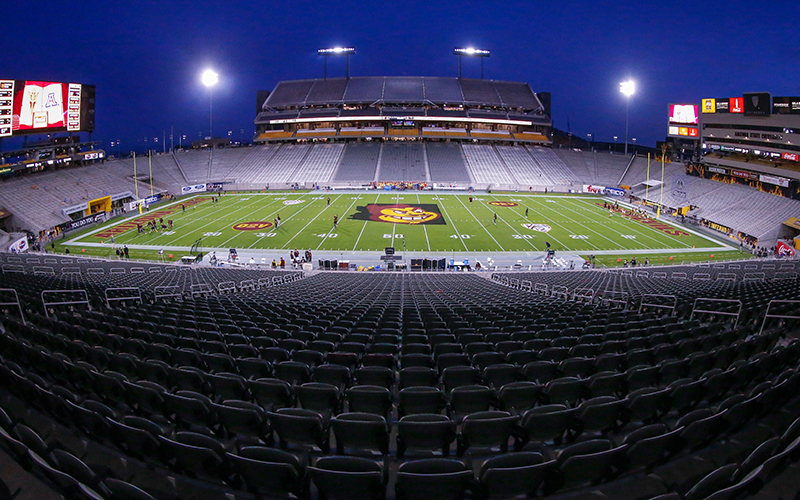
Chandler and Saguaro will square off at Sun Devil Stadium in order to crown Arizona’s first undisputed champion of high school football. (Photo by Kevin Abele/Icon Sportswire via Getty Images)
PHOENIX – When Saguaro High School takes the field at Sun Devil Stadium for a state title this Saturday, it won’t be to defend its three consecutive football championships in the 4A Conference.
The Sabercats will be playing for something bigger: the championship in the inaugural Arizona Interscholastic Association (AIA) Open Division and a claim to an undisputed title, regardless of enrollment.
“This is basically for the state championship, this is the best in Arizona,” said David Hines, executive director of the AIA.
When Saguaro takes on Chandler High School at 4 p.m. on Saturday, it’ll be a showdown between schools that have claimed all three titles in their respective conferences – Saguaro in 4A, Chandler in 6A – since the AIA went to six divisions, based on enrollment, in 2016. Chandler has won state titles in four of the last five years, while Saguaro has won a state championship in six straight years.
Those dominant runs are a major reason the AIA’s unanimously approved the implementation of Open Division back in January for the 2019 season. Based on the AIA’s computer rankings system, the Open Division pulled the top eight teams from the 4A, 5A and 6A conferences and pooled them in one bracket.
These teams included four from 6A and two each from 5A and 4A, thus opening those conferences to a different group of schools than before. It’s something Saguaro coach Jason Mohns understands even as he leads one of the schools that has dominated.
“Nobody likes dynasties. Nobody likes teams that win consistently. They want to make it fair for everyone else to have a shot,” Mohns said. “We had no issues. We were challenging ourselves with our non-conference schedules, playing out-of-state teams, playing 5A and 6A schools in Arizona.”
But Mohns said he and the players in his program heard the chatter from “the outside,” leading them to relish the chance to show just how good their program has been, even if they’ve been doing so in a division of smaller schools.
“We’re tired of people trying to downplay our accomplishments,” Mohns said. “To have the opportunity to kind of shut some of those people up, I think it’s really, for us, more of where the value is. We never felt any less about our accomplishments, but it’s nice for our kids.
“Our kids are the ones who have to hear it. They hear it from their peers, ‘Oh yeah, but you guys don’t play anybody. You guys don’t do this.’ I think our kids looked at it as an opportunity to say, ‘No, look at us now. You say we don’t play anybody, but throw these teams against us and see how we’re doing.'”
In Hines’ eyes, one of the major reasons that schools wanted the change was to get better games throughout the state playoff rounds.
“The games that we had for the first two rounds of the Open and the first three rounds of the conferences were really good games, which was really the intent of the committee that we have competitive postseason games,” Hines said. “In the past, when we had 1 play 16 and these good teams all spread out, they were blowout games.
“People weren’t attending, and the interest wasn’t there. But now, the interest really got ramped up every round that we went through. And it got better and better, to where in the semifinals, we had really, really good games.”
Between the Open Division and the three largest conference levels from which teams can go to the Open (4A, 5A and 6A), seven of the 16 quarterfinal games were decided by single digits. Six of eight semifinal games were decided by single digits, including four games decided by four points or less.
By taking the top eight teams from 4A, 5A and 6A into the Open Division, the playoffs in those conferences were opened to a wider pool of teams, giving more schools a chance to go deeper into the state playoffs.
“Our 6, 5 and 4A games are going to be really fun, competitive games where schools are going to be there for the first time and some teams will be there that haven’t been there for years,” Hines said. “We’re excited and we feel like that first year has really done exactly what we hoped it would be.”

University of Arizona football coach Kevin Sumlin believes the new Open Division will be beneficial for Arizona high school football, especially from his perspective of recruiting. (Photo by Kevin Abele/Icon Sportswire via Getty Images)
There’s even been a benefit to colleges as well. Arizona coach Kevin Sumlin has been a fan of the shift to the Open Division, which gives Sumlin and his staff the chance to evaluate more schools and to see some of the players at the top schools face other high-quality competition.
“It’s great. It’s great. There was a lot of good players playing last Saturday night,” Sumlin said. “There’s a lot of good players playing the week before, on Friday night. Those guys have continued to play all year, so it’s more than just the Open Division. You’ve still got the other classes that are playing, and there are some really good football teams playing.”
Sumlin has gotten an up-close look at how the Open Division can impact schools, as his son Jackson played his senior year for Salpointe Catholic in Tucson. The Lancers had reached the 4A finals the prior two seasons, but lost a close semifinal game to Chandler in the Open Division. Despite Salpointe’s loss, Sumlin appreciates the value in the new format.
“In that Open Division, when they seeded the top eight teams, you’re seeing some really, really good football. And a lot of talent in that bracket,” Sumlin said. “I thought it was a great idea.”
That will be especially true on Saturday, when the Open Division championship game kicks off. Though Hines doesn’t care who plays in the game, he found it fitting that Chandler and Saguaro were the two teams to reach the final, something he hopes will get football fans all across the state interested in coming to Tempe.
The Wolves and Sabercats are both ranked in USA Today’s most recent Football Super 25 Expert Rankings
“We’re fortunate that we have the No. 10 ranked team in the country (Chandler) playing the (No. 20) ranked team in the country (Saguaro) from Arizona in our championship game,” Hines said. “To have two teams ranked in the Top 25 nationally to play for our championship, we can’t ask for any more than that.
“We would love to have as many people there as possible. We’d love to set a state record for attendance for a state championship game. If we could get in excess of 20-25,000, we would be tickled.”
Mohns wants to be clear that he doesn’t think there’s anything that can be said or done to “downplay” their prior championships. But he concedes that, for his players, the chance to make an unassailable claim is one that they’re itching to earn.
“This one obviously is special because it’s a chance for us to be the Arizona state champion,” Mohns said. “There’s no arguing between the fans about, ‘Oh, this team in 6A is obviously better,’ or, ‘This state champion is better than the other state champion.’ This year, for the first time ever, there really is one true state champion, and we’ve got a shot to be that team.”
